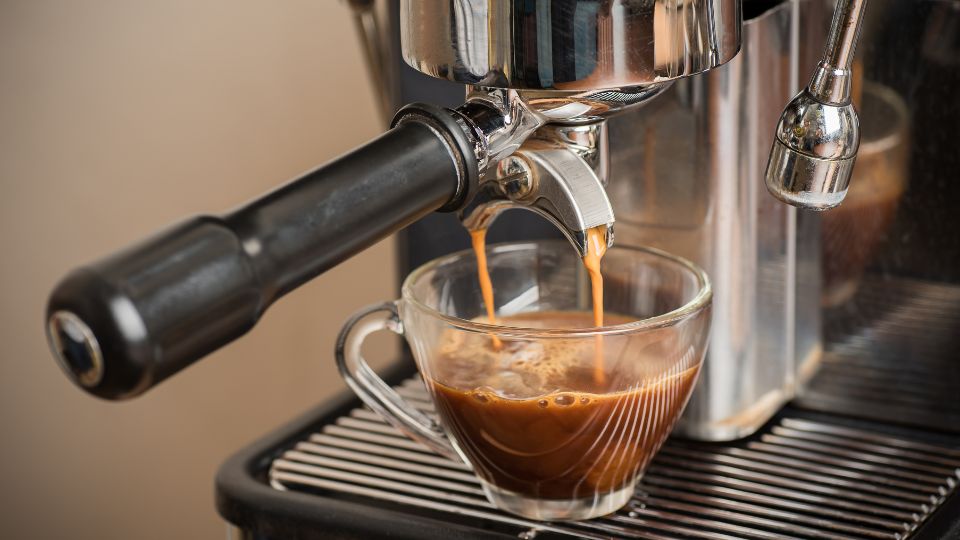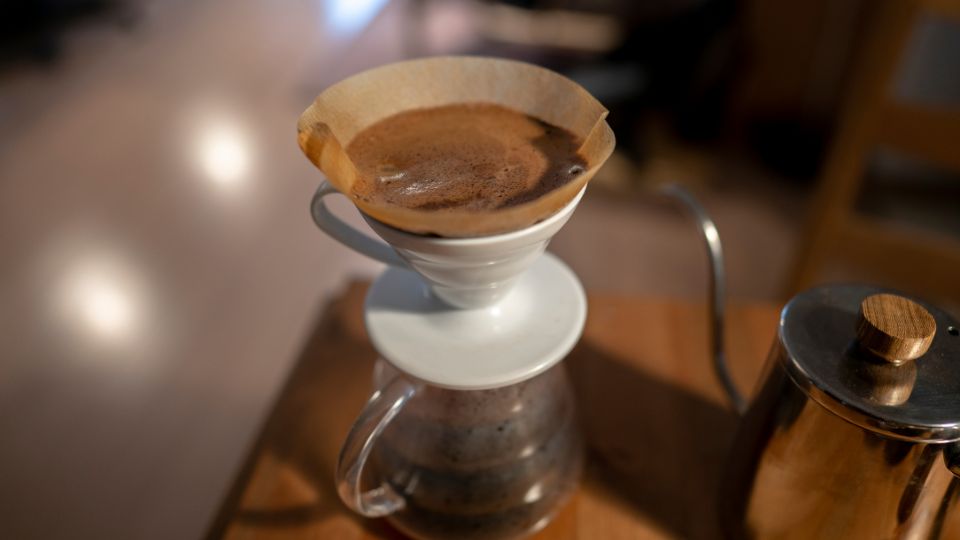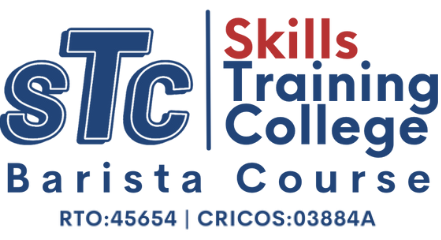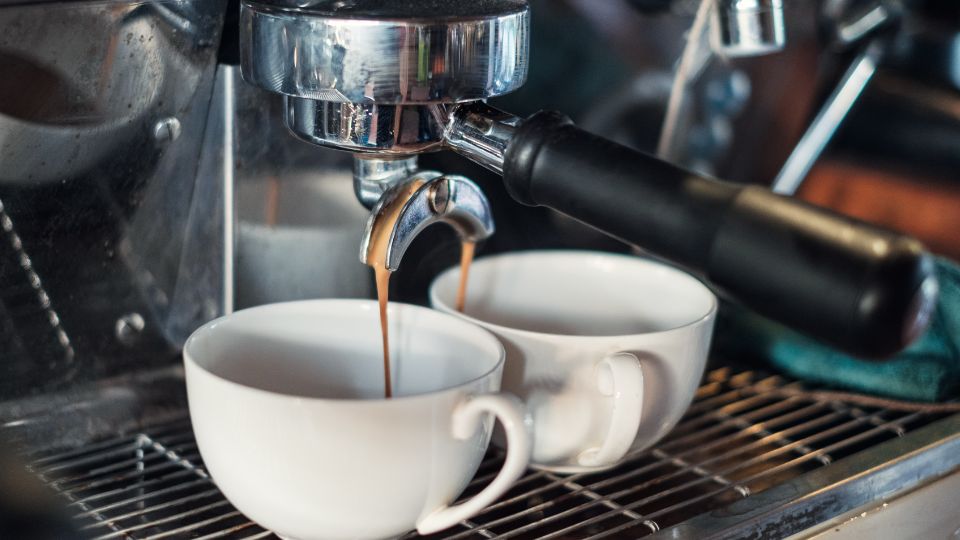Does flow profiling affects espresso extraction? Flow profiling is a technique used in espresso machines to change the pace and pressure of the water during extraction. Flow profiling can influence espresso extraction in the following ways:
- Pre-infusion: Pre-infusion is the method of applying a tiny amount of water to the coffee grounds before the main extraction begins. Flow profiling can help to soak the coffee grounds evenly and avoid channelling by regulating the flow rate and pressure during pre-infusion.
- Extraction speed: Flow profiling can impact the extraction speed of coffee by adjusting the flow rate and pressure during the extraction. Slower extraction may provide a more balanced and nuanced flavour, which might influence the flavour profile of the final espresso shot.
- Channeling: Channeling is a typical problem in espresso extraction. The water seeks the path of least resistance through the coffee grounds, resulting in uneven extraction and a weaker shot. By managing the flow rate and pressure, flow profiling can help to decrease channeling.
- Crema: Crema is the layer of foam that forms on top of an espresso shot and is an important part of the experience. By modulating the flow rate and pressure during extraction, flow profiling can change the thickness and texture of the crema.
Flow profiling can impact the quality and consistency of espresso extraction considerably. Flow profiling can help to produce a more tasty and balanced shot of espresso by allowing for greater control over the flow rate and pressure.
What Is A Flow Control Valve?
A flow control valve manages the rate at which water is pushed through the coffee bed during brewing. It gives baristas more control over the extraction process, enhancing flavour and aroma. Some important details about flow control valves in coffee extraction are as follows:
- Purpose: The water flow rate during brewing is adjusted with the help of a flow control valve. Baristas can adjust brew time, water flow, and pressure for their desired extraction.
- Types: Several flow control valves are used during the brewing of coffee, including pressure regulators, ball valves, and needle valves. Each variation has a particular set of advantages and disadvantages.
- Mechanism: The espresso machine’s mechanism can be found in the water supply pipe, where a valve regulates the water flow. Water pressure is controlled by adjusting the valve, which can be done manually or electrically.
- Benefits: Using a flow control valve improves coffee extraction’s uniformity, flavour extraction, and aroma profiles, among other benefits. They allow baristas to play around with brewing settings for more nuanced flavour profiles.
- Challenges: The necessity for exact adjustments is one of the key difficulties of using flow control valves in coffee extraction. The coffee’s taste can be drastically altered by even little adjustments to the flow rate or pressure. Baristas need to know how different variables affect the brewing process and the finished product.
- Applications: Flow control valves find widespread usage in settings where precision and uniformity are of the utmost importance, such as in specialty coffee shops and competitions. Pre-infusion, pressure profiling, and temperature regulation are just a few of the modern espresso machine features that frequently include them.
The future looks bright for flow control valves in coffee extraction, especially in light of the rising popularity of specialty coffee. Opportunities for invention and experimentation are expanding as new technologies are created to increase the accuracy and control of the brewing process.

Can The Pressure And Flow Rate Be Controlled Right From The Start?
Modern espresso machines include complex features like pressure and flow profiling, which allow baristas to regulate the pressure and flow rate from the start of the brewing process. Here’s how it works:
- The ground coffee is loaded into a portafilter basket and put into the espresso machine’s grouphead.
- Water is pumped through the coffee puck at higher pressure using a pump, extracting the coffee’s flavours and fragrances.
- Pressure profiling enables the barista to change the brewing pressure throughout the extraction process, which can modify the rate at which water travels through the coffee puck and hence the flavour and fragrance profile of the coffee.
- Flow profiling allows the barista to tailor the amount of contact time between water and coffee during the extraction process, influencing the flavour and fragrance profile of the coffee.
- The barista can control how much water travels through the coffee puck by controlling the brew pressure and flow rate. This affects the extraction characteristics.
- The barista can utilise different coffees, set the best flow profile on each grouphead and switch flow profiles with the same coffee to achieve varied outcomes.
Overall, employing advanced capabilities in most commercial machines, pressure and flow rate can be regulated right from the brewing process, allowing for personalisation and precision in the extraction process.
How Does Slower Flow Rate Affect Extraction?
A slower or low flow rate can significantly affect the extraction of coffee, which relies on the water passing through a bed of ground material. Using a finer grind is one of the most typical changes to create slower flow rates.
Fine grind size is sometimes required to maintain a consistent extraction time when using a slower flow rate. This is because the water has more time to interact with the coffee grounds. In contrast, a coarser grind would allow water to pass through too rapidly, resulting in under-extracted coffee.
Lowering the pump pressure is another method for achieving slower flow rates, although it has certain disadvantages. Lower pressure can cause a slower flow rate. Still, it can also cause less consistent extraction due to changes in flow rate and channelling (when water chooses the path of least resistance through the coffee bed, avoiding some parts).
Controlling flow rate manually, such as by adjusting the valve on a manual espresso machine, can be a more precise technique for controlling extraction than merely altering pump pressure. It enables more precise adjustments to the flow rate, resulting in a more balanced and constant extraction.
However, it is crucial to remember that when the flow rate is exceedingly sluggish, the extraction can become over-extracted. This can result in bitter coffee because the water spends too long in contact with the coffee grounds, causing flavour ingredients to be extracted excessively.
Finding the appropriate mix of flow rate, grind size, and pump pressure is critical to making a great cup of coffee.

How To Change The Flow Rate?
Changing the flow rate setting is important in regulating the real flow and controlling the extraction process during espresso preparation in the coffee industry.
Baristas can control the flow rate by adjusting the grind size of the coffee beans, tamp pressure, or the water pressure in the extraction chamber. A finer grind increases water flow resistance, resulting in a slower flow rate. In contrast, a coarser grind permits water to flow more quickly.
Tamp pressure can also affect flow rate; a stiffer tamp might restrict the flow, while a looser tamp can speed it up. Additionally, baristas can manage the flow rate by adjusting the water pressure in the extraction chamber. Increasing the pressure can speed up the flow while decreasing the pressure will slow it down.
It is important to remember that the flow rate setting can greatly affect how the espresso tastes and how good it is. As a result, baristas must experiment with flow rates to achieve the desired flavour profile for the espresso. Baristas may learn to alter the flow rate setting to produce consistently high-quality espresso shots with practice and experience.
Methods For Changing The Flow Setting
Changing the flow rate setting in coffee can be done in various ways, depending on the coffee brewing method utilised. Here are some popular methods for changing the flow rate:
- Espresso machines: The flow rate of an espresso machine is mostly determined by the water pressure and the coffee grind size. Baristas can enhance the flow rate by increasing the grind size or decreasing the water pressure. They can alter the grind size to a finer setting or raise the water pressure to slow the flow rate.
- Pour-over coffee: Pour-over coffee is an immersion method in which hot water is poured over coffee grounds. Baristas can alter the water pouring technique to control the flow rate by changing the height and pace of the pour.
- French press: The steeping period in the French press process controls the flow rate. Baristas can reduce the steeping time to raise the flow rate or increase the steeping time to lower the flow rate.
- Drip coffee makers: Drip coffee makers use a flow rate control device to adjust the water flow over the coffee grounds. Baristas can modify the flow rate by adjusting the water flow control valve, which controls the pace at which water drips onto the coffee.
To get an excellent taste and flavour profile, altering the flow rate setting in coffee involves experience and practice. Baristas should understand the variables that affect flow rates and how to adjust them to get the best results.
Can We Adjust The Restrictor Until You Reach The Desired Flow Rate?
A coffee machine’s restrictor can be adjusted to control the flow rate of water passing through the coffee grounds. This is frequently accomplished by altering the grind size of the coffee beans or the water pressure, both of which can be adjusted by the restrictor.
You may get the desired flow rate by adjusting the restrictor, which will ultimately alter the taste and intensity of the coffee. However, the particular manner of changing the restrictor may differ depending on the type of coffee maker being used.
What Is The Ideal Flow Time For Espresso?
Generally, the recommended flow time for a shot of espresso is between 20 and 30 seconds. This is the time necessary for water to pass through coffee grounds under pressure and extract the desired flavours and fragrances.
A flow time of less than 20 seconds may provide a weak and under-extracted shot. In contrast, a flow duration of more than 30 seconds may produce a bitter and over-extracted shot. However, the appropriate flow time may differ depending on coffee bean type, roast level, and personal taste preferences.

What Is Pressure Profiling In the Espresso Extraction?
Pressure profiling is the process of adjusting the machine pressure during espresso extraction to obtain a desired flavour profile. It entails altering the pressure at various extraction stages to optimise the extraction of various flavour components.
Starting the extraction at a lower pressure than usual can help to pre-infuse the coffee and bring out more subtle flavours. The pressure can gradually increase as the extraction progresses to extract more powerful flavours. This can be done manually by changing the espresso machine’s pressure gauge or using a pressure profiling machine.
It is critical to maintaining stable pressure during the extraction to ensure consistency. The machine’s pressure gauge can monitor the pressure reading and adjust as needed to keep the pressure within the specified range.
The pressure can be promptly reduced at the end of the extraction to minimise over-extraction and bitterness. Overall, pressure profiling provides greater control over the espresso extraction process, resulting in a more complex and tasty shot of espresso.
What Is the Best Flow Rate And Pressure For Espresso?
Various criteria, such as coffee bean type, roast level, and personal taste preferences, determine the ideal flow rate and pressure for espresso extraction. For espresso extraction, the flow rate of the majority of commercial equipment ranges from 250 to 500 grams per 30 seconds (g/30s) with a pressure range of 7 to 11 bars.
On the other hand, some specialty coffee businesses may want to use varied flow rates and pressure ranges to generate a certain flavour profile. They may, for example, employ pressure profiling devices to control the pressure and flow rate during extraction to generate a distinct flavour profile.
A quick flow rate may result in an under-extracted shot with a mild flavour. In contrast, a slow flow rate may result in an over-extracted shot with a bitter flavour. Similarly, an uneven flavour profile might result from a pressure that is too high or too low.
Ultimately, the optimal flow rate and pressure for espresso extraction provide a balanced and tasty shot of espresso that corresponds to the individual’s taste preferences.
What Is The Relationship Between Flow And Pressure?
Flow and pressure are connected parameters in coffee extraction that impact the quality of the espresso shot. The flow rate is the volume of water that goes through the coffee grounds in a given amount of time. In contrast, pressure is the force that the water exerts on the coffee grounds throughout the extraction process.
Typically, the relationship between flow rate of a pump and pressure is inversely proportional: as pressure rises, the flow rate falls, and vice versa. However, the optimal flow rate and pressure balance are determined by the specific coffee beans, roast level, and personal taste preferences.
A quick flow rate may result in an under-extracted shot with a weak flavour, whilst a sluggish flow rate may result in an over-extracted shot with a bitter flavour. Similarly, an uneven flavour profile might result from a pressure that is too high or too low.
Pressure profiling devices can adjust the flow and pressure at various stages of the extraction process, which can aid in extracting different flavour compounds and create a distinct flavour profile. It is possible to make a balanced and tasty shot of espresso that suits individual taste preferences by altering the flow rate and pressure.
Overall, the interaction between flow and pressure in coffee extraction is complex, and achieving the ideal flavour profile necessitates close attention.

What Is A Flow Profiling Espresso Machine?
A flow profiling espresso machine is a type of espresso machine that enables precise regulation of water flow rate during the extraction process. This is accomplished by adjusting the pump pressure and the opening and closing of flow valves at various extraction phases.
It is possible to extract distinct flavour compounds from coffee and generate a unique flavour profile by adjusting the flow rate during extraction. Flow profiling espresso machines are popular in specialty coffee shops and among expert baristas who want to create customised espresso shots with precise flavour profiles.
Learning flow profiling is a complicated process requiring a thorough knowledge of coffee extraction and brewing techniques. An accredited barista training provider can give you the necessary information and hands-on experience to perfect this trade.
Training with a certified barista training provider enables you access to cutting-edge equipment and technology. This is significant because flow profiling necessitates exact temperature, pressure, and water flow rates. Using cutting-edge equipment, you may experiment with various brewing characteristics and develop your abilities until you get the perfect brew.
Flow Profiling Affects Espresso Extraction Consistency
Flow profiling can improve espresso extraction consistency by allowing baristas to control the pressure and duration of water flow during extraction. Proper flow profiling can improve the complexity and balance of espresso shots by extracting different ingredients and emphasising specific flavours, acidity, and sweetness.
On the other hand, incorrect or irregular flow profiling might result in variances in extraction and less acceptable flavour profiles. Flow profiling necessitates sophisticated equipment and abilities, and not all coffee or espresso drinks are appropriate for this technique. When done correctly, flow profiling can considerably impact espresso extraction uniformity.
What Is The Difference Between Flow Rate And Flow Profiling?
The fundamental distinctions between flow rate and flow profiling in coffee extraction are as follows:
| Flow Rate | Flow Profiling |
| Refers to the volume of water passing through the coffee grounds per unit of time | Refers to the ability to control the flow rate of water during different stages of extraction |
| Determines the speed of the extraction process | Allows for the extraction of different flavour compounds at different stages of extraction |
| Important for achieving a balanced extraction | Important for creating a customised flavour profile |
| It can be adjusted manually or automatically on some machines | Requires a machine with flow profiling capabilities |
| Typically, a consistent flow rate is desired for a balanced extraction | The flow rate can be adjusted to extract specific flavour compounds, such as acidity or sweetness |
| Flow rate affects the amount of coffee solubles extracted and the extraction rate | Flow profiling can help to create a unique and complex flavour profile |
Does Coffee Agitation Affect The Flow Profiling?
Flow profiling in espresso extraction can be affected by coffee agitation. The passage of water through the coffee bed when producing an espresso shot can considerably impact the flavour and quality of the resulting espresso. Flow profiling is the practice of regulating the flow of water during extraction to optimise the flavour profile of the coffee.
The distribution of coffee particles within the filter basket can be changed by agitating the coffee bed. If the coffee is stirred excessively, the particles may become irregularly distributed within the filter basket, resulting in channelling during extraction. When water seeks the path of least resistance through the coffee bed, it channels, resulting in uneven extraction and perhaps off-flavours in the espresso.
However, some agitation can be advantageous for flow profiling. For example, a little tap of the portafilter can help settle the coffee bed and generate an equal extraction. Additionally, some baristas utilise a method known as “pulse pouring,” which involves alternating the flow of water on and off during extraction to help generate an equal extraction.
In conclusion, coffee agitation can impact flow profiling in espresso extraction. Finding the proper balance is essential for producing a high-quality espresso shot.

How To Test Espresso Machine Pressure Profiling?
The following steps are commonly taken while testing an espresso machine pressure profiling system:
- Install a pressure gauge: First, add a pressure gauge to measure the pressure of the water as it goes through the espresso machine. This is usually accomplished by connecting the gauge to the brew head or portafilter.
- Run a shot without pressure profiling: Run a shot without pressure profiling: Use the pressure profiling tool to run a shot of espresso. This will establish a baseline for comparison.
- Run a shot with pressure profiling: Use the pressure profiling tool to run another shot of espresso, taking note of the pressure settings and how they are modified during the extraction.
- Compare the outcomes: Compare the pressure and flow rates of the two shots. Examine the taste, texture, and crema for any variations. There should be discernible changes between the two shots if the pressure profiling is effective.
- Repeat the process: Repeat the process multiple times to guarantee consistency, altering the pressure settings as needed until the desired flavour profile is reached.
Evaluating an espresso machine pressure profiling system requires careful observation and experimentation to get the desired results. It’s critical to keep track of each shot’s pressure and flow rate values to create a consistent profile for future extractions.

